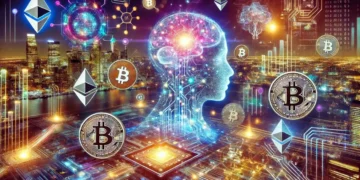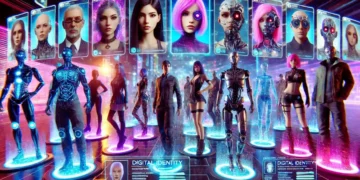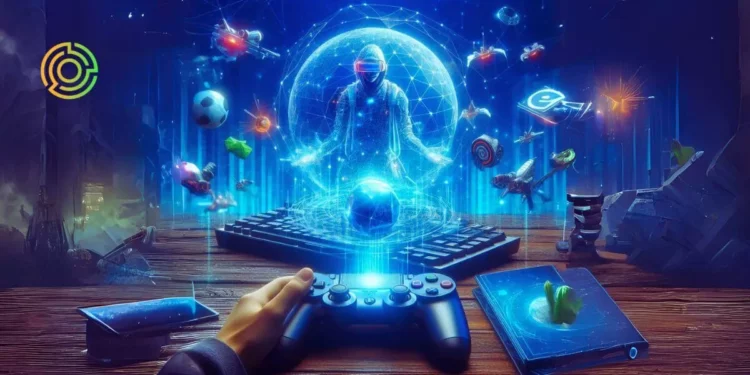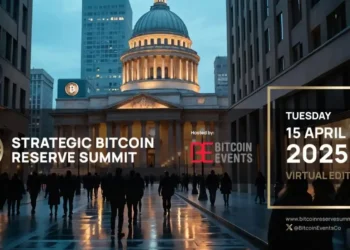The gaming industry has undergone an extraordinary evolution over the past few decades. From its early days focused on arcade machines and consoles, to today where it encompasses mobile platforms, PC and virtual reality.
The Gaming Industry and its evolution
In the 1980s, arcades and console systems like the Atari 2600 dominated the gaming landscape. Games were often simple in design to fit the limitations of the hardware. The release of the Nintendo Entertainment System in the late 1980s helped revive the console market with more advanced technology.
The 2000s brought the rise of mobile gaming on smartphones, which became a multi-billion dollar industry in its own right. Casual gaming for anyone, anytime, anywhere became a reality. The decade also saw the rise of massively multiplayer online games, where millions of people could play together at the same time.
Understanding the Metaverse
The concept of the metaverse envisions a future version of the Internet in which users interact in three-dimensional virtual environments, creating a universal virtual realm. Although still in its infancy, proponents see the metaverse as the next evolutionary step for the Internet.
The term “metaverse” was coined by Neal Stephenson in his 1992 science fiction novel “Snow Crash” as an immersive virtual reality-based experience. Today, however, the concept often goes beyond virtual reality to include aspects of augmented reality and cross-platform unity.
In a metaverse development company, users access virtual experiences and interact with others through virtual avatars. Proponents envision a world in which the metaverse replaces the current Internet as we know it by enabling truly immersive experiences. In this model, the metaverse functions as a digital infrastructure where the physical and digital worlds seamlessly merge.
Metaverse development services promise to enable new types of experiences through its inherently three-dimensional and immersive nature. Users can attend virtual concerts, access virtual classrooms, work in virtual offices, shop, play games, and socialize, all through their digital avatars. Virtual and augmented reality hardware, such as VR viewers and AR glasses, can allow users to interact with the metaverse.
Although still in its early stages, some tech giants such as Facebook are investing billions in developing metaverse platforms. If realized, the vision of the metaverse could transform the way we work, learn, socialize, and entertain ourselves in a truly virtual world. However, there are challenges related to privacy, governance, accessibility, and the environmental impact of such a pervasive digital infrastructure.
The Impact of the Metaverse on Videogames
The concept of the metaverse has the potential to significantly impact and transform the gaming industry. If realized, the metaverse could essentially function as a giant virtual game world where gameplay seamlessly merges with other virtual experiences.
Current video game trends are already moving in this direction. Massively multiplayer online games allow games to function as social virtual worlds in their own right. Massively multiplayer online role-playing games (MMORPGs) such as World of Warcraft create massive persistent game worlds with millions of players.
Advanced 3D capabilities and complete immersion in the metaverse could enhance this experience. Users could seamlessly access a vast, unified metaverse game world across multiple devices: PCs, consoles, VR headsets, and AR glasses. Within this universe, players could engage in multiple game genres and collaboratively explore shared spaces through their personalized avatars.
The social and experiential aspects of the metaverse also have significant implications for video games. Players could watch others play, attend in-game concerts and events, or interact within game worlds in new ways beyond simply playing the game. The economies and communities built around today’s online games could expand into the metaverse.
For gaming companies, the development of the metaverse represents an opportunity to build massive virtual worlds that function as platforms in their own right. Publishers could create metaverse game worlds that live beyond individual titles, generating revenue through in-game purchases, subscriptions, advertising, and eSports.
How the Metaverse Will Break Down the Barriers of the Video Game Industry
Today, different gaming platforms present barriers to gamers. Exclusive titles on consoles limit the audience, and the lack of cross-platform compatibility divides PC and console gamers. This division is fracturing the gaming community. Metaverse development services could bridge this gap, allowing players on any device to connect in a shared game world. This has the potential to significantly expand the player base and enrich the social connections within games.
The metaverse could also remove barriers related to device limitations. Traditional gaming requires sitting in front of a fixed screen. Integrating the metaverse of virtual and augmented reality could enable truly immersive and flexible gameplay on the go. Players could continue to play seamlessly across devices and forms.
The social and collaborative nature of the metaverse could make video games more inclusive. The emphasis on interacting through avatars rather than in person could provide more opportunities for introverts and people with social anxiety to comfortably engage with others. Shared gaming environments could also encourage a wider range of gameplay styles beyond the traditional competitive modes.
Video game monetization opportunities for the metaverse.
The Metaverse represents a significant opportunity for gaming companies to diversify their revenue streams beyond traditional game sales and in-game purchases. As a shared virtual realm, the metaverse opens up numerous potential revenue streams for game publishers.
If metaverse development serves as a platform in its own right, games could become applications within that platform rather than standalone products. This could allow publishers to generate recurring revenue from their metaverse games through subscriptions and in-game micropayments. For example, players could pay monthly access fees to highly immersive MMO games or make regular purchases of virtual goods.
Reinventing Game Design in the Metaverse
The metaverse allows for greater flexibility in gameplay by removing the limitations of physical devices. Games can be played on any hardware interface, from VR viewers to AR glasses. Designers can create experiences that move dynamically between media. Game mechanics can also evolve beyond the confines of 2D screens.
The social and shared nature of the metaverse enables new types of collaborative play. Designers can emphasize teamwork, community, and economic building over traditional competition. Massively multiplayer experiences may become the norm. Metaverse development services themselves may even become social platforms where players organize meetings and events.
Transforming eSports and competitive gaming in the Metaverse
Metaverse platform development companies have the potential to radically transform eSports and competitive gaming. The shared virtual world of the Metaverse could enable truly immersive, large-scale multiplayer gaming and competitive gaming.
Current eSports are limited by the constraints of 2D displays and single-platform matchmaking. The 3D virtual environment and cross-platform compatibility of the Metaverse could enable multiplayer gaming and competition on a much larger scale. Entire stadiums filled with spectators could interact live in the metaverse during eSports events.
Implications for Game Developers in the Metaverse
The rise of the metaverse will have a profound impact on how game developers approach design, platform development, and business models. Some notable ways in which game developers may be affected include
- Game Design – Developers of metaverse platforms will need to rethink game design paradigms to take advantage of the metaverse’s three-dimensional virtual realms, social interactions, connectivity, and hardware versatility. Both established genres and innovative designs unique to the metaverse will be essential to its development.
- Development – Creating metaverse games will likely require unique and complicated development tools, workflows, and skills. There may be a need to develop native metaverse engines and middleware. Developers will also need to prioritize interoperability, data portability, and platform harmony.
- Team Structures – Multidisciplinary teams that include expertise in 3D art, VR/AR, simulation, online systems, and virtual economy design will become standard. Social and community management skills will also be valuable.
- Monetization – Traditional game sales may shift to recurring revenue models such as subscriptions, micropayments, and platform fees. Metaverse developers will need strategies for acquiring and distributing virtual goods.
- Competition – As the metaverse evolves into a platform, developers will face competition not only from other games, but also from the metaverse itself and other participants in the software ecosystem.
- Regulation – Issues such as privacy, security, intellectual property, and platform governance will become more complex, requiring compliance and legal expertise.
- Hardware – Metaverse platform developers need to stay abreast of the evolving capabilities and limitations of VR, AR, and other technologies on which the metaverse relies.
- Culture – Building for the metaverse will require a cultural shift within metaverse platform development teams toward more collaborative, persistent, and socially conscious designs.
Challenges and Opportunities of Designing for the Metaverse
The metaverse presents both opportunities and challenges for user experience and human-computer interaction design. On the positive side, the immersive 3D virtual environments and instant connectivity of the metaverse enable entirely new forms of interactive experiences. Designers have the opportunity to influence how people live, work, and play in this new environment.
However, designing for metaverse development comes with many complexities. Technical challenges include creating intuitive interactions for a variety of input devices, from metaverse game controllers to VR gloves. Designing high-fidelity graphics and realistic avatars and environments is a high-performance requirement.
Ensuring usability and accessibility in 3D space, from navigation to object manipulation, is difficult. Standards for interoperability and data portability between different metaverse application development platforms have not yet been established.
The large-scale, multiplayer nature of the metaverse makes social and community design extremely important. However, minimizing toxicity, managing user behavior, and providing a sense of security and trust remain challenges.
Enabling meaningful and productive work and learning experiences in virtual worlds requires novel interactive and collaborative tools. However, the implications of extensive use of the metaverse for human productivity, well-being, and society are not yet fully understood.
If approached responsibly and inclusively, design for the metaverse has the potential to change our lives and interactions for the better. But realizing this vision will require addressing the complex challenges of balancing technological progress with human values. The opportunities for positive impact through design are significant, but so are the risks of exacerbating existing problems if care and foresight are not applied.
Integrating the Metaverse and the Real World
The metaverse is envisioned as a virtual world that is seamlessly integrated with the physical world. Although largely virtual, the metaverse seeks to blur the boundaries between digital and real experiences. A key goal of metaverse development solutions is to augment reality, not replace it. Users should be able to move seamlessly between virtual and physical worlds without major interruptions. There are several ways this integration can occur:
- Mixed Reality Hardware – Devices such as AR glasses could overlay virtual content on top of real-world views, merging the two. VR viewers could enable brief virtual “teleportations” from physical locations in the development of metaverse applications.
- Real objects as anchors – Physical objects could serve as anchors that link the virtual and the real. Scanning a product’s barcode could enable its purchase or inspection within the metaverse.
- Physiological Tracking – User biometrics such as eye tracking, gestures, and brain activity could be input data within the metaverse and also affect virtual avatars. Physical activity in VR could translate to fitness in real life.
- Shared Spaces – Physical locations could exist seamlessly in both the metaverse and the real world. Users could begin by organizing face-to-face meetings virtually. Changes made in virtual spaces could eventually affect their real-world counterparts.
- Economic Flow – Virtual currency could be exchanged for real money and vice versa. Virtual items could be purchased in the physical world. Virtual work could generate real income.
- Real-world data – Information from the physical world could flow into the metaverse to enhance virtual representations and simulations. Traffic patterns, weather conditions, product availability, and more could flow into the metaverse.
As the metaverse evolves, its integration with the real world in a variety of ways could provide unprecedented opportunities for virtual experiences to enhance, rather than supplant, physical reality. However, it will be critical to maintain a balanced relationship between the virtual and the real, maintaining a healthy distinction while facilitating meaningful connections.
The Future of the Metaverse
The metaverse is still in its infancy, but it has the potential to become a truly transformative technology platform. While many questions remain about how the Metaverse will take shape, here are some possibilities for its future:
- Ubiquity – Over time, access to the Metaverse could become as seamlessly integrated into daily life as the Internet is today. Users could interact with it through a variety of ubiquitous devices.
- Maturity – As the metaverse evolves, its infrastructure is expected to become more stable, secure, and interoperable. Standards and governance models may evolve to facilitate widespread adoption.
- Specialization – Different metaverse platforms may emerge, tailored to specific use cases such as gaming, work, and socialization. However, there is likely to be some degree of interconnectivity between these fragmented virtual worlds.
- Mixed Reality – The metaverse integration of virtual and augmented realities is likely to become more sophisticated, enabling truly immersive and compelling digital experiences.
- Societal Impact – As the metaverse increasingly influences how people interact, learn, work, and play, its impact on society as a whole, both positive and negative, will become more apparent. Efforts will be needed to ensure inclusiveness, security, and privacy.
- Economic Integration – The metaverse may see greater convergence between its virtual economies and real-world markets. The value and exchange of digital assets may become more standardized.
Ultimately, the development of metaverse applications has the potential to radically reshape the way we interact with technology and each other. As the metaverse evolves, it will be critical to address the technical, ethical, and social challenges that arise. But if implemented carefully, the metaverse could open a new chapter in the history of digital connectivity, providing more immersive, collaborative, and meaningful experiences for generations to come.
See also: Metaverse Made Simple – The Ultimate Guide to Understanding the Metaverse
Conclusion
The metaverse is more than a futuristic idea; it is a tangible possibility that promises to revolutionize not only the gaming industry, but also the way we interact with technology and each other. From game design to real-world integration, the potential of the metaverse is vast and exciting.
As this new digital frontier continues to evolve, it is imperative that we address the technical, ethical, and social challenges that arise along the way. Only with careful consideration and strategic planning will we be able to take full advantage of the opportunities the metaverse offers while mitigating potential risks.
Ultimately, the future of the metaverse is in our hands. By working together as experts, designers, developers, and the community at large, we can create an inclusive, safe, and exciting metaverse that transforms our digital experience in ways we cannot yet fully imagine.
FAQs
What is the Metaverse?
The Metaverse is a virtual reality in which multiple virtual worlds merge into a shared and expansive digital universe where users can interact with each other and with three-dimensional digital environments.
What is the potential of the metaverse for the gaming industry?
The Metaverse has the potential to transform the gaming industry by enabling more immersive, collaborative, and social gaming experiences. Game developers can create interconnected virtual worlds that transcend the boundaries of individual games and offer opportunities for ongoing monetization through subscriptions, in-game purchases, and more.
How will the metaverse affect the interaction between the virtual world and the real world?
The Metaverse aims to seamlessly integrate the virtual and real worlds through technologies such as augmented reality and virtual reality. This could enable hybrid experiences where users can interact with objects and people in both digital and physical environments.
What are the major challenges in developing the metaverse?
Some of the key challenges include creating interoperability standards between different metaverse platforms, ensuring the security and privacy of user data, and mitigating potential negative effects such as technology addiction and the creation of social divides.
How do I get started exploring the metaverse?
There are several ways to begin exploring the metaverse, from participating in virtual reality games and applications to experimenting with augmented reality devices. It is important to research and try different platforms to find the one that best suits your interests and needs.
What potential does the metaverse have for games?
The Metaverse has the potential to revolutionize gaming by introducing expansive, immersive virtual worlds that transcend individual titles and open up new avenues for gameplay, community building, and monetization. Through VR/AR, the metaverse could transcend the limitations of 2D screens and offer spatial and collaborative gaming experiences.
As a platform for multiple games and virtual economies, the shared virtual space could generate ongoing revenue streams beyond initial game sales. The social elements of metaverse development could reshape gaming culture, fostering greater inclusivity and accessibility. By realizing this vision, the gaming industry could play a pivotal role in promoting the widespread adoption of the metaverse.
Are metaverse games the future?
The metaverse promises to transform the gaming landscape through features such as cross-device continuity, spatial gaming, virtual economies, expansive cross-game communities, and innovative monetization methods. However, there are many challenges related to metaverse governance, security, hardware limitations, and privacy concerns that could hinder its widespread adoption.
It is unknown if and when the necessary infrastructure, standards, and user access points will be in place to support a fully realized metaverse gaming ecosystem. While some aspects of metaverse gaming may become part of the future landscape, gaming may evolve in other ways. Much depends on how the metaverse itself evolves in practice over the next few years.
What gaming companies are investing in the metaverse?
Several major companies developing applications for the metaverse have made significant investments to explore the gaming possibilities of the metaverse. These include Epic Games, creator of Fortnite, which has positioned itself as a potential metaverse gaming platform. Microsoft and Roblox have also invested heavily in metaverse game research and development. Other gaming companies that have invested heavily include Snap, Electronic Arts, Ubisoft, Niantic (Pokémon Go), and Tencent.
Facebook/Meta has poured billions into metaverse development, notably through projects like its Horizon virtual reality platform, with the goal of building metaverse gaming capabilities from the ground up. Numerous video game companies see the metaverse as an enticing frontier for game and community development.
What is Web3 Gaming?
Web3 gaming refers to the development of metaverse games based on decentralized blockchain and cryptocurrency technologies, with the goal of giving players more power, ownership, and earning potential through mechanisms
Proponents of Web3 argue that these systems can cut out middlemen and give players true ownership over their assets and game outcomes. Opponents, however, argue that Web3 often merely decentralizes business models and perpetuates many of the problems of traditional games, such as manipulation and pay-to-win mechanics.
How large is the metaverse gaming market?
The size of the metaverse gaming market is difficult to accurately predict, given the nascent and speculative nature of the industry. Some estimates suggest that the metaverse gaming market could exceed $490 billion by 2030, thanks to the proliferation of VR/AR hardware and persistent online game worlds.
However, these projections depend on many assumptions about technology development, hardware adoption rates, and user behavior that may not prove to be accurate. For example, in 2021, the global gaming market had total revenues of approximately $180 billion. However, if a robust and easy-to-use metaverse gaming ecosystem were to emerge that could capture even a fraction of the total spending on metaverse game development, the potential market size would likely be enormous, representing a significant business opportunity.
Follow us on our social networks and keep up to date with everything that happens in the Metaverse!
Twitter Linkedin Facebook Telegram Instagram Google News Amazon Store











































